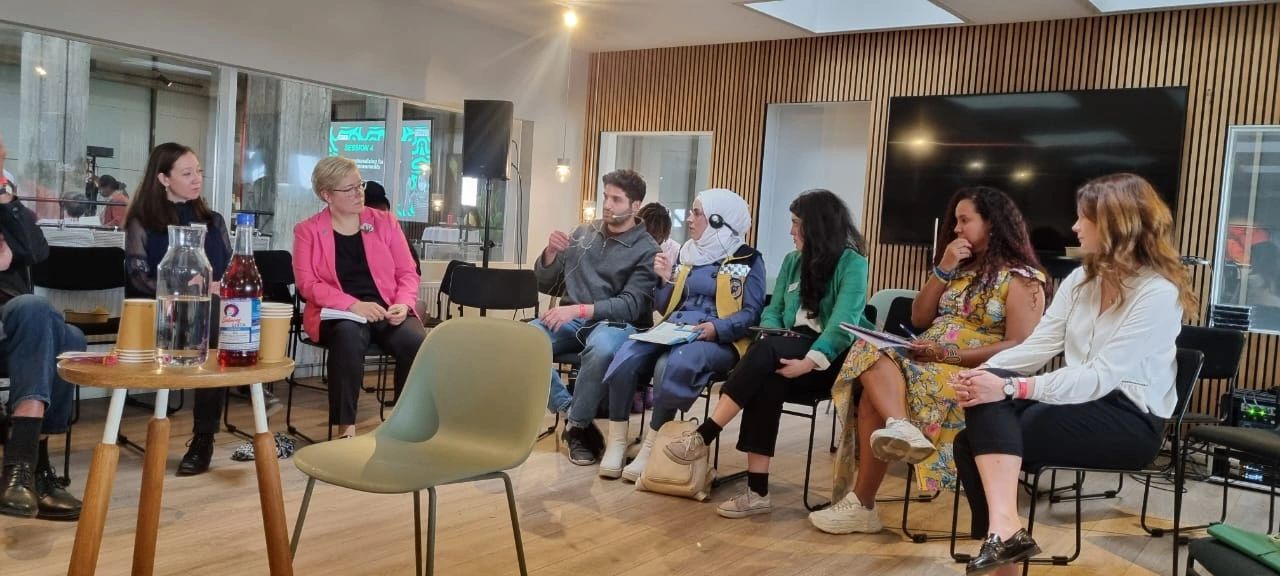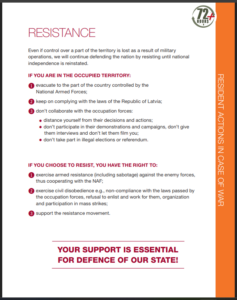Minds of the Movement
An ICNC blog on the people and power of civil resistance
by Amber FrenchJune 16, 2025
Cliquez ici pour lire cet article en français
This article was first published in the issue #213 of the French journal Alternatives non-violentes, released in December 2024. The below version has been updated and modified.
-
The Russian invasion of Ukraine. The rise of Russian-style hybrid warfare. General receptivity to the idea of nonviolent resistance in Latvia, one of the two Baltic states that share a border with Russia, has never been lower. It was the US Special Operations Forces (US-SOF) and NATO that succeeded in drawing the Latvian state's attention back to civilian-based defense (CBD), presented as an integral part of national defense. The question of how to implement this concept remains rather delicate in Latvia to this day—with the exception of a growing number of initiatives with another label—"comprehensive defense"—among them, a very convincing defense education project.
“Whole-of-society defense” or "comprehensive defense" is a military concept that emphasizes the broad participation of society in the defense of a national territory against influence, invasion and occupation. Proponents of comprehensive defense see civilians as one of the responsible parties in national defense, whether they are engaging in violence, nonviolent resistance or some other category of action.
Comprehensive defense is based on cooperation between civilians and the armed forces, planned and coordinated by the state, the armed forces and the public. This distinguishes it from nonviolent civilian-based defense (CBD), which refers only to more organic, unarmed civilian initiatives. However, such academic categories that try to surgically separate "violent resistance" from "nonviolent resistance" do not fully capture how resistance to occupation happened in the past, much less ongoing defense preparation in Taiwan and resistance in occupied Ukraine today. (Still, it's always helpful to have categories in the social sciences!)
What opportunities does the rising popularity of comprehensive defense unlock for practitioners and proponents of nonviolent action? The case of Latvia provides us some insights on this question.

Author co-presents with Katrina Kaktina, Latvian Ministry of Foreign Affairs, on nonviolent strategies in war zones, Copenhagen, April 2025. Credit: Author.
"Occupation requires the obedience of the people"
The US Special Operations Forces (US-SOF), a cross-cutting command founded in 1987 that enables the different branches of the US military to coordinate in joint operations, is responsible for exhausting all unarmed options to prevent the outbreak of armed conflict in foreign countries, according to a US-SOF advisor who, for operational reasons, wishes to remain anonymous. Nonviolent action is seen as having strategic merits in its own right, as an inexpensive “option” and particularly interesting for its intrinsic value as a deterrent. It is considered an integral part of national defense, and therefore an "auxiliary to armed operations". In other words, nonviolent action is viewed as serving to decentralize responsibility for defending a national territory.
It may seem surprising (it was at least for me!) that the US-SOF encourages and advises the Latvian government to take advantage of nonviolent action. In fact, “nonviolent resistance has been part of US doctrine since the Second World War”, says my US source, clarifying that the references are mainly conceptual rather than operational terms. Why is this? Because it must be “led by civilians," he specifies. "Civilian institutions are better placed to carry out strikes and civil disobedience. Occupation and, to some extent, subjugation require the obedience of the people,” explains my source, echoing our great thinkers on civil disobedience.
Indeed there are many nuances and tensions around CBD and comprehensive defense, the latter being more present today in Latvia, despite the extensive and successful practice of stand-alone unarmed civilian defense there during the Soviet occupation. Despite the public's lack of receptivity to all that is labeled "nonviolent" at present, the Latvian government is logically preparing its people for CBD through “crisis preparation” programs. In particular, it has launched a very popular and convincing defense education program in high schools, inspired by comprehensive defense and incorporating certain elements of the nonviolent corpus.
“Crisis preparedness"

Click to download brochure. Source: sargs.lv.
Latvia's National Defense Law was amended in 2020-21 to indicate what civilians can do in terms of non-cooperation (but also in terms of armed action) in the event of occupation. In 2020, the Latvian Ministry of Defense published a brochure on its website entitled “What to do in the event of a crisis”, available in English, Latvian, Russian and Braille. The brochure explains the practical steps to be taken in the event of power cuts or other problems caused by “crises” such as natural disasters, pandemics and “military operations”. Reading the section on “Residents' actions in the event of war”, one page is devoted to “resistance”, and we observe that nonviolent action by “residents” (acts of non-cooperation, strikes...) do not necessarily occupy a lesser place in the resistance toolbox than space occupied by armed action.
No doubt because of their long history of CBD, the Latvian government seems convinced that it plays an important role in national defense—today more than ever in the face of Russian hybrid warfare. “Nonviolent resistance is a topic of discussion, and we're looking to implement it even in military training,” confides my source at the Latvian Ministry of Defense, who wishes to remain anonymous. However, given the Latvian experience during the Soviet occupation and the horrors we see in Ukraine, advocates of “nonviolent resistance” or a so-called “nonviolent civilian-based defense” campaign would probably be considered naive.
“People are more eager to learn how they can prepare and how they can support the army. They're eager to get information about crisis preparedness. They are very patriotic and support military action. People are very connected and aware of what's going on in Ukraine. They don't think they can do anything with nonviolent resistance,” concludes my source.
For my part, I deduce that the government has simply found a new framework for CBD and its related concepts within comprehensive defense, which places nonviolent action and armed action on the same strategic plane. But even so, the methods of combating cyberwarfare and disinformation, the main features of Russian-style hybrid warfare, remain entirely nonviolent, as do the strikes and non-cooperation mentioned in the Ministry's brochure.
Education and the spirit of defense

National Defense Training, Model curriculum for secondary education. Jaunsardzes Center in cooperation with the National Centre for Education and Ministry of Defence, 2024.
While the defense of culture and language against Soviet influence was a major concern in the past, the fight against Russian propaganda and the development of defense education and media literacy are current priorities for the Ministry of Defense. Cyberattacks, disinformation, propaganda... These hybrid warfare tactics have made Latvians realize that they need to double down on their efforts to introduce the spirit of defense and resilience into schools. And Latvian pupils are apparently keen to learn more about national defense in all its dimensions.
“We can really reach them as a target group,” my Latvian source tells me. “It's harder to educate adults, especially the elderly, who are difficult to bring together physically. Plus, they already have their own life experiences and beliefs,” he continues. Children bring home new knowledge, for example about the importance of participation in elections and media literacy, and are therefore a more promising group to target with educational initiatives on defense.
There are no programs (yet?) explicitly on what I myself would label "nonviolent action" as such, but the state's defense program includes the history of local resistance (including nonviolent), cyberdefense strategies, “civic activism”, patriotism, critical thinking, adventure training, forest survival and winter survival. The program began as a pilot project in 2018 and is now mandatory for students in their junior or senior year. It consists of one one-day session per month.
The course has been very well-received by schools and students, according to my source. The program started with 12 schools, then 50 the following year, and has grown from there. The main challenge is to train enough instructors.
The strategic merits of nonviolent action
It's hard to deny the effectiveness of nonviolent action when armed forces integrate it into their strategic doctrine and wartime training. It is nevertheless very provocative to completely instrumentalize nonviolent action or to pursue it only to further war and killing. The reality is that war and conflict will persist. We need to study nonviolent action in conjunction with armed action, as it manifests itself in the real world today—and comprehensive defense provides us practitioners and researchers of strategic nonviolent conflict an excellent entry point.
More pointedly for the short term, defense education must not stop at military concepts; the nonviolent corpus enriches our resilience to modern war and other types of political violence. Nonviolent action is an inexpensive, inclusive, effective and autonomous way for people to defend democracy and freedom on their own ... and it starts with education.
Additional sources unavailable online
- Jacques Semelin, Jean-Marie Müller and Christian Mellon, La Dissuasion civile (Fondation pour les études de défense nationale), 1986.
- Unpublished interviews conducted by author between January 2024 and June 2025 with a US-SOF advisor who wishes to remain anonymous, a Latvian Ministry of Defense representative who wishes to remain anonymous, and Anna Marija Knoka (Latvia Ministry of Defense).
--
This article was written and translated into English by Amber French in a personal capacity. The opinions expressed in this article are those of the author and do not reflect the views of ICNC.

Amber French
Amber French is Senior Editorial Advisor at ICNC, Managing Editor of the Minds of the Movement blog (est. June 2017) and Project Co-Lead of REACT (Research-in-Action) focusing on the power of activist writing. Currently based in Paris, France, she continues to develop thought leadership on civil resistance in French.
Read More